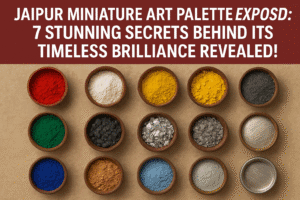Jaipur Miniature Art Palette EXPOSED: 7 Stunning Secrets Behind Its Timeless Brilliance Revealed!
Jaipur’s miniature paintings have long mesmerized with their intricate detail and vibrant colors, and a recent study of master artist Babulal Marotia’s pigments uncovers the rich blend of tradition and innovation behind their enduring brilliance. Using advanced scientific methods, researchers mapped 42 pigments revealing timeless natural minerals like vermilion and orpiment alongside surprising toxic arsenic compounds and modern synthetic materials such as Prussian blue and aluminum foil.
Notably, some historic pigments like insect-based reds and lead white have disappeared, reflecting shifts in availability, ethics, and artistry. Marotia’s pragmatic approach prioritizes color quality over safety, highlighting a cultural legacy where craftsmanship transcends material risks. This research not only aids conservation by identifying rare pigments but also traces centuries of trade and cultural exchange influencing Indian art. Ultimately, Marotia’s palette embodies India’s evolving artistic heritage, bridging past and present while inspiring future creativity with a deep respect for tradition. As he says, “Colors carry stories. My job is to keep them alive.”

Jaipur Miniature Art Palette EXPOSED: 7 Stunning Secrets Behind Its Timeless Brilliance Revealed!
For centuries, Jaipur’s miniature paintings have captivated audiences with their intricate details and vibrant hues. Yet the secrets behind their enduring brilliance have remained largely unexplored—until now. A groundbreaking study of 42 pigments from the workshop of master artist Babulal Marotia reveals a fascinating blend of ancient traditions and modern adaptations, offering new insights into India’s artistic heritage.
Bridging Art and Science: The Quest to Map India’s Pigments
Led by Harvard University’s Mapping Color in History project, researchers analyzed pigments used in Marotia’s workshop, combining advanced techniques like Raman spectroscopy and electron microscopy. The goal? To create an open-access database for identifying materials in South Asian art—a critical resource for conservators and historians alike.
Key Findings: Where Tradition Meets Innovation
Timeless Classics
- Hinglu (Vermilion): Sourced from Rajasthan mines, this mercury sulfide pigment has adorned Indian art for millennia. Marotia uses both natural cinnabar and a processed version mixed with kaolinite, showcasing traditional refinement techniques.
- Harital (Orpiment): This arsenic sulfide yellow, once prized in Mughal manuscripts, remains a staple. Interestingly, one sample contained sulfur crystals, hinting at historic purification methods involving roasting.
Surprising Discoveries
- Arsenolite (White): A toxic arsenic trioxide pigment, likely inherited from Marotia’s father, challenges assumptions about historical safety practices. Its presence suggests artisans prioritized color fidelity over health risks.
- Soorma (Galena): Traditionally an antimony-based eyeliner, this lead sulfide pigment’s use in art is unprecedented. Its magnetic cousin, barium ferrite (a synthetic brown), underscores artists’ experimentation with modern materials.
Modern Adaptations
- Neel (Prussian Blue): While indigo (from the neel plant) remains in use, a synthetic Prussian blue mix—with calcite and barium sulfate—reveals how artists balance cost and tradition.
- Ranga (Aluminum): Replacing silver due to affordability and corrosion resistance, this hand-ground aluminum foil reflects evolving material choices in contemporary practice.
The Missing Pieces: Lost Pigments and Shifting Practices
Absences in Marotia’s palette tell their own story. Insect-based reds (lac, cochineal) and plant dyes (madder) common in historical works are missing, possibly due to fading popularity or sourcing challenges. Lead white, ubiquitous in Mughal-era art, is replaced by kaolinite clays and even arsenolite—a stark reminder of how regional availability shapes tradition.
The Artist’s Lens: Color Over Chemistry
Marotia’s approach defies modern safety norms. “I select pigments for their hue, not their composition,” he admits, citing thorough handwashing as his only precaution. This pragmatism highlights a cultural ethos where artistry trumps material risks, preserving techniques passed through generations.
Implications for Conservation and Beyond
- Preservation: Identifying rare pigments like galena or barium ferrite aids in accurate restoration, preventing damaging mismatches.
- Historical Trade Routes: Synthetic ultramarine and chrome yellow point to 19th-century European influences, mapping globalization’s impact on local crafts.
- Ethical Shifts: The absence of Indian yellow (once made from cow urine) reflects evolving ethical standards and legal bans.
Conclusion: A Living Legacy
Marotia’s palette is a microcosm of India’s artistic evolution—a dance between heritage and innovation. As scientific databases grow, they not only decode the past but empower future artists to experiment responsibly. As the master himself notes, “Colors carry stories. My job is to keep them alive.”
You must be logged in to post a comment.